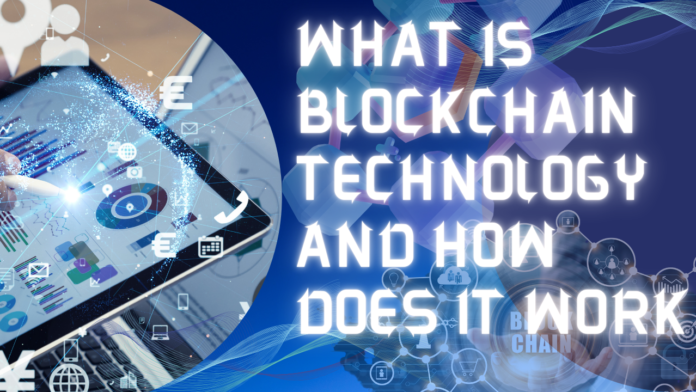Introduction to Blockchain Technology
Blockchain technology has become a buzzword in recent years, capturing the imaginations of tech enthusiasts, investors, and even skeptics. But what exactly is it? Often intertwined with cryptocurrency, blockchain serves as the backbone for digital currencies like Bitcoin and Ethereum. However, its potential stretches far beyond just financial transactions.
Imagine a secure digital ledger that records every transaction transparently without relying on a central authority. That’s the essence of blockchain—a decentralized network designed to enhance security and trust across various applications. As we delve deeper into this revolutionary technology, you’ll discover how it works, its real-world implications, and why it’s poised to shape our future in ways we can only begin to comprehend. Whether you’re curious about cryptocurrency or simply intrigued by innovative technologies, understanding blockchain is key to navigating today’s rapidly changing landscape. Let’s unlock the secrets behind this fascinating concept together!
The Basics of Blockchain: Decentralization and Security
Blockchain technology is fundamentally rooted in the principles of decentralization and security. Unlike traditional systems that rely on a central authority, blockchain distributes data across a network of computers, making it resistant to single points of failure.
This decentralized structure enhances transparency. Each participant can verify transactions independently without needing trust in intermediaries. This openness builds confidence among users.
Security is another cornerstone of blockchain. Through cryptographic techniques, each transaction is encrypted and linked to previous ones, forming an unchangeable chain. If someone attempts to alter a block, they would need to change all subsequent blocks—an almost impossible task given the vast number of participants involved.
These elements work together to create a robust framework for various applications beyond just cryptocurrency. They pave the way for innovations ranging from supply chain management to secure voting systems.
How Does Blockchain Work?
Blockchain operates as a distributed ledger technology. It records transactions across multiple computers, ensuring that every participant in the network has access to the same information.
When a transaction occurs, it is grouped with others into a block. Each block contains cryptographic hashes of the previous one, creating an unbreakable chain. This design prevents tampering and fraud.
Once verified through consensus mechanisms like proof-of-work or proof-of-stake, blocks are added to the chain permanently. Every node in the network updates its copy of this ledger simultaneously.
The decentralized nature enhances security by eliminating single points of failure. It also increases transparency since all participants can audit transactions independently without intermediaries involved.
This framework underlies various applications beyond just cryptocurrency, revolutionizing industries such as finance, supply chain management, and healthcare.
Advantages and Applications of Blockchain Technology
Blockchain technology offers numerous advantages that extend beyond cryptocurrency. Its decentralized nature ensures data integrity, making it difficult for any single entity to manipulate information. This feature is particularly beneficial in sectors like finance, where transparency and security are paramount.
Another advantage is the reduction of transaction costs. By eliminating intermediaries, blockchain streamlines processes across various industries such as supply chain management and healthcare. This not only saves money but also enhances efficiency.
Applications of blockchain continue to expand into areas like voting systems and digital identity verification. These innovations promise greater trust and accountability in democratic processes as well as personal data protection.
Moreover, smart contracts automate agreements without the need for a mediator. This capability significantly reduces delays and disputes while promoting trust among parties involved in transactions or collaborations.
Challenges and Limitations of Blockchain
Blockchain technology, while revolutionary, is not without its hurdles. One significant challenge is scalability. As the number of transactions increases, many blockchains struggle to maintain speed and efficiency.
Energy consumption poses another concern. Mining activities require substantial computational power, raising questions about sustainability and environmental impact.
Interoperability also presents issues. Various blockchain networks often operate in silos, making communication and collaboration between them difficult.
Regulatory uncertainty can hinder adoption as governments around the world grapple with how to classify cryptocurrencies and related technologies. This ambiguity creates a complex landscape for developers and businesses alike.
Security vulnerabilities remain a constant threat. Despite being inherently secure due to encryption methods, human error or poorly coded smart contracts can lead to breaches—highlighting that no system is entirely foolproof in safeguarding assets against potential attacks.
Real-World Examples of Blockchain Implementation
Blockchain technology is not just a theoretical concept; it has found practical applications across various industries.
In supply chain management, companies like Walmart leverage blockchain to enhance transparency. By tracking products from farm to shelf, they ensure food safety and authenticity.
Healthcare providers utilize blockchain for secure patient data sharing. This fosters trust while maintaining privacy in medical records.
Financial institutions are also on board. Ripple’s network enables instantaneous cross-border transactions, reducing costs and time significantly compared to traditional methods.
Even the art world benefits through tokenization of artworks via Non-Fungible Tokens (NFTs). Artists can sell digital creations directly to consumers without intermediaries.
These examples illustrate how blockchain solves real problems today, paving the way for further innovation across sectors. The versatility of this technology continues to inspire new projects and collaborations worldwide.
The Future of Blockchain Technology
The future of blockchain technology appears promising and robust. As industries recognize its potential, adoption rates are surging across various sectors.
With the rise of decentralized finance (DeFi), traditional banking systems may face disruption. Blockchain can streamline transactions, reduce costs, and enhance user experience.
Moreover, advancements in smart contracts could redefine how agreements are executed. This automation minimizes human error and improves efficiency.
Environmental sustainability is another focal point. Innovations like proof-of-stake consensus mechanisms aim to minimize energy usage while maintaining security.
Governments and institutions are exploring regulatory frameworks for cryptocurrencies, further legitimizing the space. Such regulations could pave the way for safer investments.
Additionally, interoperability between different blockchains might soon become a reality. This would allow seamless communication among diverse networks, unlocking new opportunities for collaboration.
As these developments unfold, they will shape an exciting landscape where blockchain technology continues to evolve and influence everyday life.
Introduction to Blockchain Technology
Blockchain technology has emerged as a transformative force in the digital landscape. At its core, it is a decentralized ledger that securely records transactions across multiple computers. This innovation eliminates the need for intermediaries, creating trust through transparency.
The concept may seem complex, but it’s fundamentally about data integrity and security. Each transaction is grouped into blocks and chained together in chronological order. Once recorded, altering any information becomes nearly impossible without consensus from the network.
As interest grows around cryptocurrency and blockchain applications, understanding this technology’s potential becomes crucial. It’s not just about financial transactions; industries like supply chain management, healthcare, and finance are exploring its vast capabilities.
With ongoing advancements and increasing adoption rates globally, blockchain stands at the forefront of technological evolution—paving new paths for how we exchange value and information.
Understanding the Basics: What is a Blockchain?
A blockchain is essentially a digital ledger. It records transactions across multiple computers in such a way that the registered data cannot be altered retroactively without affecting all subsequent blocks.
At its core, this technology promotes transparency and security. Each block contains a number of transactions and is linked to the previous one, creating an unbreakable chain. This structure ensures that every user has access to the same information.
Another key aspect is decentralization. Unlike traditional databases controlled by central authorities, blockchains operate on peer-to-peer networks. This reduces vulnerability to hacks or fraudulent changes.
Blockchain can be applied beyond cryptocurrency; it’s transforming various sectors like supply chain management, healthcare, and finance. Its ability to provide trust and verification makes it revolutionary for our digital future.
Key Components of Blockchain Technology

Blockchain technology is composed of a number of fundamental aspects through which it is able to operate and retain integrity.
To begin, the distributed ledger is a shared record-keeping system among the nodes. This decentralisation reduces pressure on data loss and contamination.
Second, cryptographic hashing protects against fraudulent transactions by transforming data into a standard-sized string. Through this process, it is guaranteed that any update in transaction information will lead to a completely different hash rendering any fraud virtually impossible.
Third, consensus algorithms are important for transaction validation. They allow network subscribers to reach consensus about the state of the blockchain without the need for central authority.
Smart contracts automate processes within the blockchain ecosystem. These self-enforcing contracts remove intermediaries and decrease efficiency and expenses for different uses.
Conclusion
As we move into the realm of blockchain technology, it is evident that the revolutionary concept is far beyond a building block for tokens. It is changing many industrial sectors by providing improved security and decentralization. Securing data storage in an irreversible ledger has widespread applications that range from finance to supply chain management.
The future looks bright for both blockchain and cryptocurrency. As the technologies continue to advance and real-world uses are becoming more and more frequent, it is becoming increasingly clear that these technologies will be found naturally working in tandem. With the increase of knowledge about the fundamentals of cryptocurrency and blockchain, people can understand this changing world more comfortably.
Although challenges still exist—e.g., scalability problems and regulatory issues—there are of course and considerably greater gains, with much to be gained outweighing the difficulties. Examples taken from the real world have shown successful applications in various fields, demonstrating that practical applications are not limited only for digital currencies.
To adopt blockchain technology is to enter a new transparency and efficiency world. No matter whether one is interested in the phenomenon itself or its uses in banking or logistics, it will be important to keep abreast of developments if one is to realize the full extent of the phenomenon’s potential going forward.


